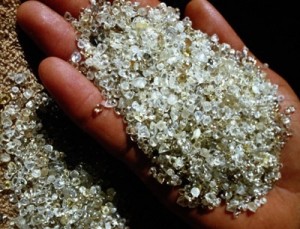 Mumbai: Rough diamond producers will have to slash prices further as a 28 percent slump from a peak in 2014 may be insufficient to revive demand, according to Moody’s Investors Service.
Mumbai: Rough diamond producers will have to slash prices further as a 28 percent slump from a peak in 2014 may be insufficient to revive demand, according to Moody’s Investors Service.
Miners will remain under pressure over the next 12 to 18 months because of slowing jewelry sales and cutters and polishers’ reduced access to credit, which have caused a temporary mismatch between supply and demand, the credit rating agency said in a report December 14.
Rough diamonds prices have fallen 18 percent in the first 11 months of 2015 and dived since 2014, according to the report, “Metals & Mining — Global: Diamond Miners May Have to Cut Prices Further to Revive Demand.”
“The latest drop in diamond prices, which are down about 28 percent from a peak in 2014, may be insufficient to revive demand and we think producers may have to cut prices further as supply and demand challenges continue into 2016,” said Denis Perevezentsev, Moody’s vice president and senior credit officer as well as a co-author of the report.
“Producers’ decision to scale back production and/or sales will help rebalance the market over the next 12 to 18 months.”
ALROSA reduced prices by 3 percent in February 2015 and by another 3 percent in April. It cut prices by 8 percent in the third quarter of 2015, Moody’s said. De Beers lowered prices by 8 percent between the end of 2014 and June 2015 and slashed them by another 8 to 10 percent in August.
Miners with production facilities outside the U.S. will benefit from lower costs because of a stronger U.S. dollar against currencies such as the Russian rouble, Botswana pula, South African rand and Canadian dollar. Costs in dollar terms have declined in line with or slightly less than diamond prices, partially offsetting the negative impact of lower prices for companies such as ALROSA, De Beers and Petra Diamonds.
ALROSA, with production assets in Russia, is the least affected by the drop in prices because most of its costs are denominated in roubles, which depreciated 42 percent versus the U.S. dollar in 2014, but its revenues are mostly measured in terms of the American currency. Approximately 90 percent of its revenue in 2014 came from diamond sales, which were in U.S. dollars, while only about 10 percent of costs and 15 to 20 percent of capital spending were in the greenback, improving its profitability.
The long-term fundamentals of the sector are solid despite price drops because the limited number of new high-quality mines and high depletion rates at existing mines will help prevent an over-supply of diamonds in the long term. Moody’s expects global rough supply to continue increasing at a compound annual growth rate of 2 percent over the next five to seven years and to peak at 159 million carats in 2022, up from an estimated 135 million carats in 2015.
Production will start to fall in 2023, propping up miners’ pricing power, the report forecast.




 By
By